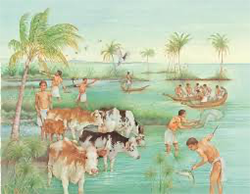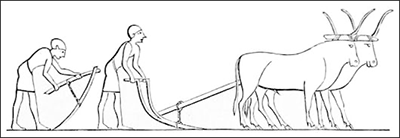Agriculture was a major industry in Ancient Egypt and a major part of life for the people who lived there.

The Ancient Egyptians grew many things for food, including grains such as wheat and barley; pulses like beans, chickpeas, and lentils; fruits such as grapes, melons, plums, and pomegranates; and vegetables such as cucumbers, leeks, lettuce, onions, peas, radishes, squashes, and turnips. Another important and tasty crop was figs.
The Egyptians depended heavily on the Nile River, not only for its water but also for its kemet, the fertile black soil that remained when the mighty river flooded annually. They built reservoirs to hold water and eventually developed a form of irrigation, digging canals and ditches to provide water flow from the Nile inland and also from the reservoirs to where it was needed.

They also made use of a water-lifting device called a shadoof, a combination of rope, a bucket, a long wooden pole, and a weight. The pole functioned as a lever resembling a seesaw. A person tugged on the rope to lower the bucket into a well or deep canal; then, when the bucket was full, the weight on the other side of the seesaw brings the bucket back up.

These ancient farmers divided their year into three seasons: Akhet, Peret, and Shemu. Peret was the season in which the land was plowed and the crops were planted. This season lasted the equivalent of five modern months, October through February. The very next month began Shemu, the season of the harvest. This season generally last three months, equating to the modern March through May. The remaining four months, equivalent to the modern June through September, were Akhet, the season of flooding. Farmers could not plant or harvest during this time because of the regular and sometimes incessant flooding of the Nile. Instead, farmers looked after their farm equipment and their homes and families. It was during this time also that many farmers spent time working for the king, helping to build structures like offices, temples, and even pyramids.

To harvest grain, the Egyptians used axes, hoes, rakes, and sickles. Archaeologists have found some all-metal tools; most tools, though, were all wood or a combination of wood and stone. The Egyptian farmers plowed their fields with plows they powered themselves or ones pulled by oxen. Other animals commonly seen on farms and in villages included cows, ducks, geese, goats, and pigs. Some animals performed tasks, such as goats that trampled the fields in order to push seeds into the ground; others were food sources for people. In addition, some Egyptians kept bees, which produced honey (for sweetening, since sugar didn't exist) and wax.
The ancient Egyptians had a somewhat ingenious method for harvesting corn. When the corn was ripe, men wielding wooden sickles cut the ears off the stalks. Behind the men came women and children, picking up the ears. After that, the farmers guided their cows over the cut corn to weed out any grain. Finally, the farmers threw the grain into the wind, so the chaff, which was lighter than the grain, would blow away, leaving what was needed. The Egyptians then ground the grain into flour to make bread and other food and also used it to make beer.

Two other major crops grown in Ancient Egypt were flax and papyrus. Flax plants were in high abundance, and the Egyptians used flax fibers to make clothing and other linen items. The Egyptians harvested papyrus reeds and used them to make baskets, boats, mats, paper, rope, and sandals.